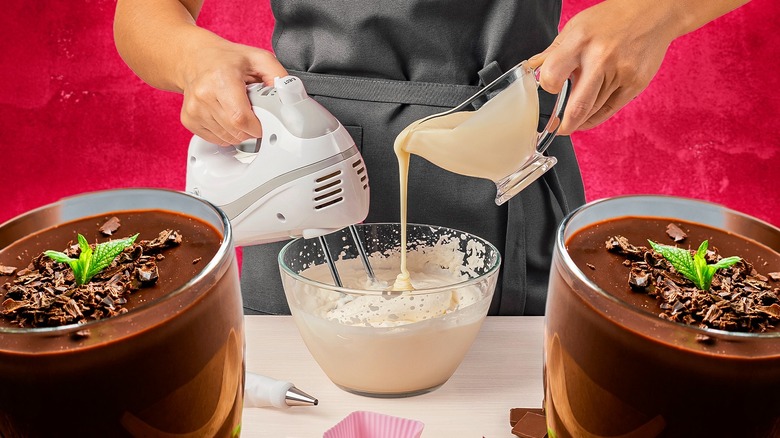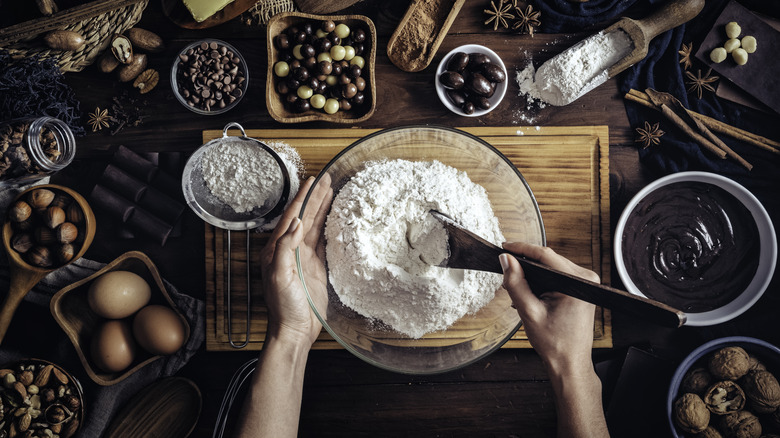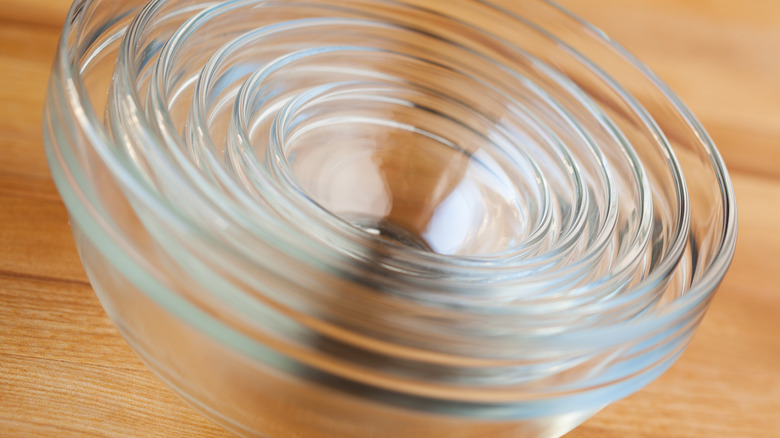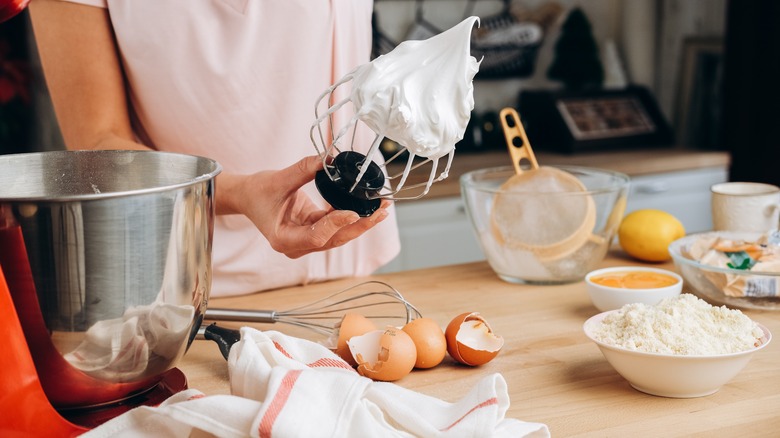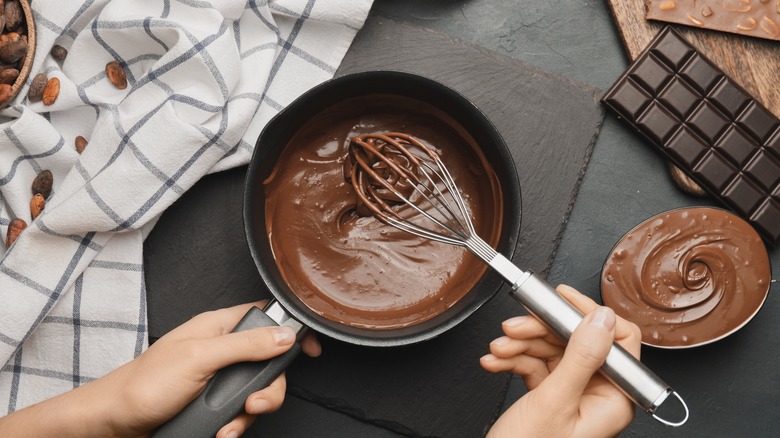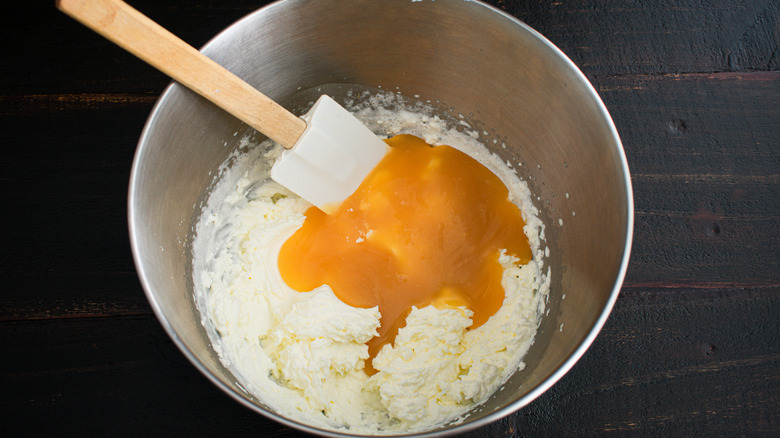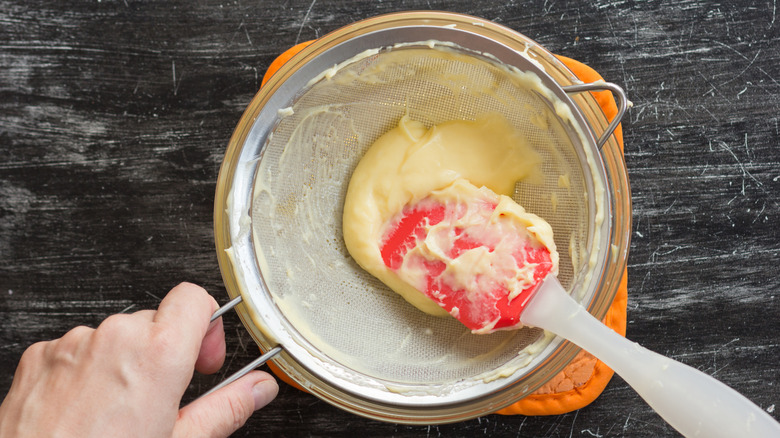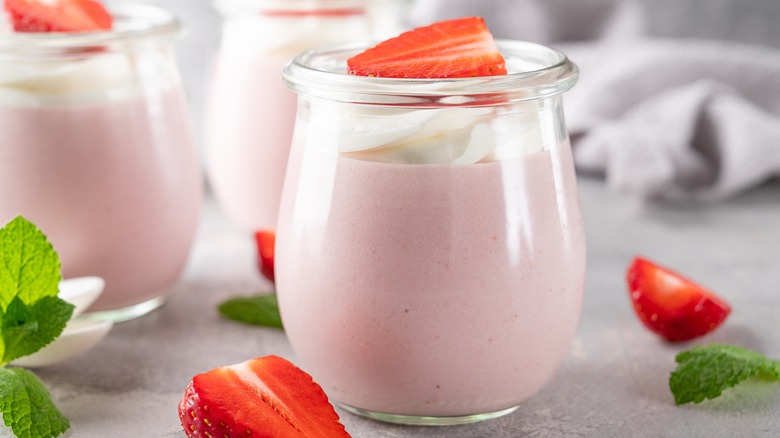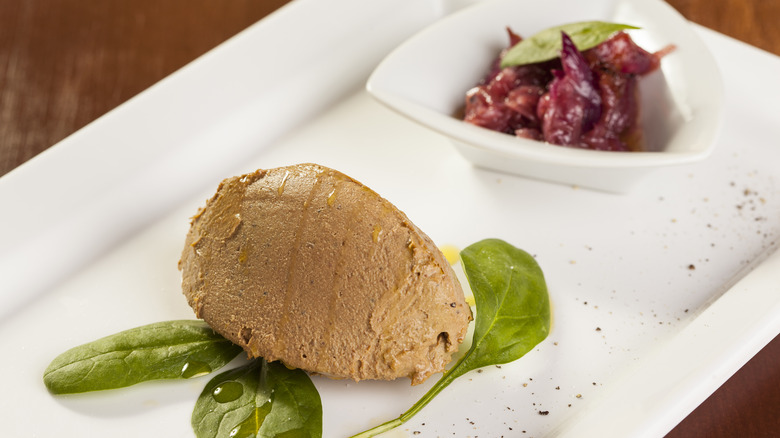8 Mistakes Everyone Makes With Mousse
Mousse is a rich and decadent dish made by combining a flavorful base with whipped cream or beaten egg whites to create a light and airy texture. Hailing from France — where it was once called mayonnaise de chocolat — mousse is often compared to pudding, which is similar. The primary difference between mousse and pudding is texture. Pudding has a thicker, denser consistency.
Mousse can serve as both a standalone dessert, like the quintessential French chocolate mousse recipe, and as an ingredient or filling in more complex dishes, like a chocolate mousse cake. It gets its flavor from the base ingredients that the egg whites or cream are combined with. Chocolate may be the most popular base for mousse, but other foods like spices, fruit, and poultry liver can also be used.
While it may sound like a simple dish to whip up, you'll need to rely on a few solid culinary techniques to make it properly. As a cooking instructor, I've used mousse to teach students how to whip egg whites and cream to the proper peak, how to safely melt chocolate without burning it for chocolate mousse, and how to gently fold ingredients together without deflating them. Even with these techniques, making mousse can be tricky. You'll have a better chance for success if you can learn to avoid these common mousse mistakes.
Getting the temperatures wrong
Temperature plays a critical role in the outcome of a mousse recipe. In fact, making a mousse requires a combination of the right temperatures and patience. Without these, your mousse will wind up a melted, grainy mess instead of a decadent, velvety treat.
Since mousse is typically a no-bake dish, we're focusing on the temperature of the ingredients used to make it instead of the oven temperature. If you've ever baked a cake, you've undoubtedly read recipe instructions that direct you to bring certain ingredients, like butter or eggs, to room temperature. This is required for best results because these items are easier to combine when they're not cold from the fridge.
Mousse requires the same attention to temperature. It gets its light texture from the air bubbles whipped into egg whites or heavy cream. Both need to be at the appropriate temperature to produce the desired result. Heavy cream should be as cold as possible when it's whipped. The fat in the cream must remain cold to trap the air needed to fluff your mousse. You can also chill your bowl and even your mixer's beaters to set yourself up for success. If you're using egg whites, they whip up best when they're at room temperature.
It's also important to consider the temperature of your flavor base. Once you've whipped air into your egg whites or cream, folding them into a base that's too warm, like freshly melted chocolate, can melt the whipped ingredients.
Using a bowl that's not squeaky clean
When you think of cleanliness in the kitchen, you likely think about preventing the spread of bacteria or foodborne illness, but a clean kitchen can also influence the outcome of your recipes. This is especially true when making a mousse with egg whites.
Egg whites can be tricky to cook with. They are extremely sensitive to heat and any oil or fat. Oil will keep the whites from whipping to the proper consistency, so it's imperative that the bowl you use to whip your egg whites is spotless, and has no sign of any fat or oil.
You can ensure your bowl is spotless by cleaning it with an acid, like freshly squeezed lemon juice or white vinegar. Pour a little of your acid of choice into the bowl and use a paper towel to wipe the bowl's surface. A gentle acid will get rid of any oil in the bowl, so you'll be able to whip your egg whites to their full potential.
Choose a stainless steel or glass bowl for whipping your whites. Unlike plastic bowls, they are easier to clean and less likely to have oil residue on their surface.
Overmixing your mousse batter
If you're a baker, you probably know that overmixing your baked goods can be problematic. The goal should always be to mix ingredients just until they are combined, and no longer. Overmixed batters can have a negative impact on the texture and rise of your baked goods. Mixing too much air into your batters will produce baked treats that are dense and flat instead of light and fluffy.
Overmixing can also affect the outcome of your mousse. When you overmix your mousse batter, you can end up with two possible outcomes. If you're using egg whites, overmixing them will cause them to develop tiny grains that will change the texture of your mousse. Extremely overbeaten egg whites will eventually deflate, and deflated egg whites won't give your mousse the airy texture you're looking for. For mousse made with heavy cream, overmixing the cream will cause it to thicken and eventually curdle, which will also cause your mousse to be grainy and dense instead of smooth and light in texture.
To prevent overmixing from ruining the texture of your mousse, follow your recipe's instructions carefully, paying close attention to the time and visual cues that indicate when your egg whites or cream are ready for use.
Burning the chocolate
Chocolate mousse is a quintessentially French dessert, and as fancy as it may seem, you can make it at home with your chocolate of choice. For chocolate mousse, melting the chocolate is key, and it will likely be the first step in your recipe. Melting chocolate may not sound difficult, but it's a task that's easy to mess up, even for serious cooks. There's no coming back from overcooked chocolate. The burnt bitterness will overpower all other flavors in your mousse. Burnt chocolate will also pass its grainy texture into your mousse.
Chocolate has a low melting point because of the cocoa butter it contains. It starts to melt at about 93 degrees Fahrenheit. Easy melting can also mean easy burning.
Melting chocolate can be done on the stovetop with a double boiler, or in the microwave. For the microwave, heat the chocolate in short intervals and check it frequently. Different microwaves operate at different power levels, with some working faster than others. Melting chocolate in a double boiler is a gentler method. The steam produced by the double boiler provides indirect heat, which melts the chocolate slowly, making it much more difficult to burn.
Flubbing the folding
Folding is a key step in making a mousse. Once your cream or egg whites are whipped, the next step is to combine them with the flavor base. The only way to accomplish this is by folding. Folding is the process of combining two ingredients when one is delicate. In this case, your whipped cream or egg whites are the delicate flowers. If stirred too vigorously or handled too harshly, they will lose the air incorporated into them. Folding allows you to combine ingredients gently without deflating your whipped whites or cream.
The right way to fold in egg whites and heavy cream is to stir a small amount of the whipped whites or cream into your flavor base. The goal here is to lighten the base so that it's easier to fold in the rest. Next, add more of the whipped whites or cream to the base and use a silicon spatula to slice through the center of the ingredients in the bowl. Gently drag the spatula along the bottom of the bowl and up one side of the bowl, turning the spatula to fold the ingredients over so what was on the bottom is now on the top. Repeat this until your whipped whites or cream are fully incorporated and no white streaks remain.
Folding takes longer than stirring, but the end result is well worth the extra time. If you don't fold your ingredients together properly, your mousse will be flat with no fluff.
Not straining the custard
You've probably gathered that texture and consistency are extremely important when making a proper mousse. That velvety smooth, cloudlike texture is the hallmark of a good mousse, and there are numerous ways to achieve it. Straining your custard or the flavor base of your mousse is an easy way to ensure that your mousse is super smooth.
For many mousse recipes, the first step is to make a custard base, like pastry cream. Custards are typically made on the stovetop. Milk and cream combine for a well-balanced custard, along with sugar and eggs, which can be gently heated and stirred or whisked constantly until they thicken into a silken, creamy custard. Once the custard is cooled, the whipped egg whites or heavy cream are folded into the custard base.
Lumps are why you need to strain the custard base for homemade mousse. Eggs are extremely sensitive to heat, and even when added with care, they can start to cook or curdle if your custard's not completely cool. The cooked eggs will form lumps in your custard. Bits of unmelted sugar can also create a lumpy custard. Straining the custard through a fine mesh strainer can get rid of any lumps in your custard, so it's smooth and creamy.
Skipping the chill
Mousse is a perfect dish to serve at a dinner party, because it has to be made in advance. It's not a food you can whip up at the last minute, so it's important to include the chilling time your mousse requires when you're planning to make and serve it.
The last step in making a mousse, after all of the stirring, whisking, and folding, is chilling the mousse. Giving the mousse some time in the fridge before serving is an important last step in ensuring your mousse has the proper consistency. The amount of time your mousse needs to chill may vary depending on your recipe, but all types of mousse need to be chilled. Some recipes recommend chilling your mousse for as little as 30 minutes, while others require a minimum of two hours.
Chilling your mousse allows the flavors to meld and develop, and helps the mousse set properly, giving it a firm yet creamy consistency. This also makes it easier and neater to serve. If you're serving your mousse in individual bowls or glasses, add it to your serving dishes before chilling. The smaller portions will chill faster, and they'll be ready to serve straight from the fridge.
Forgetting that mousse can be sweet and savory
Mousse is often thought of as a decadent dessert, but its potential goes far beyond dessert plates. Embracing the idea of a savory mousse opens doors to appetizers, side dishes, and even main courses that are elegant, flavorful, and unexpected.
For a sweet mousse, chocolate, fruit purees, or custards are commonly incorporated to create a rich dessert. On the savory side, ingredients like pureed meat and poultry, vegetables, and even seafood, can be blended into a mousse. The result is a creamy and flavorful dish perfect for any occasion.
Savory mousse is made the same way as the sweet variety. A flavor base is lightened by folding in whipped, unsweetened heavy cream. In this case, the flavor base can be made with everything from pureed avocado to fresh cucumbers and herbs. Pork and pureed chicken liver are also popular options for mousse. Mousse made with these meats are like a smoother, lighter version of pate.
Mousse's versatility makes it a flexible dish that can cater to a wide range of tastes and occasions, from indulgent desserts to sophisticated savory dishes.
Static Media owns and operates Tasting Table, Mashed, and Food Republic.
